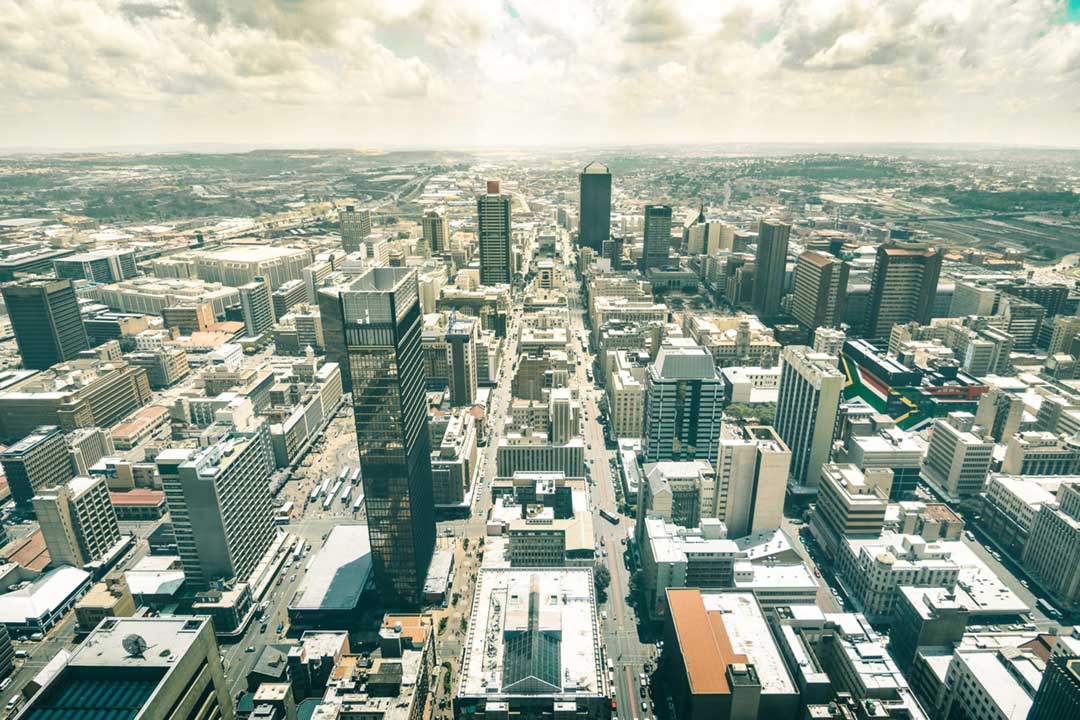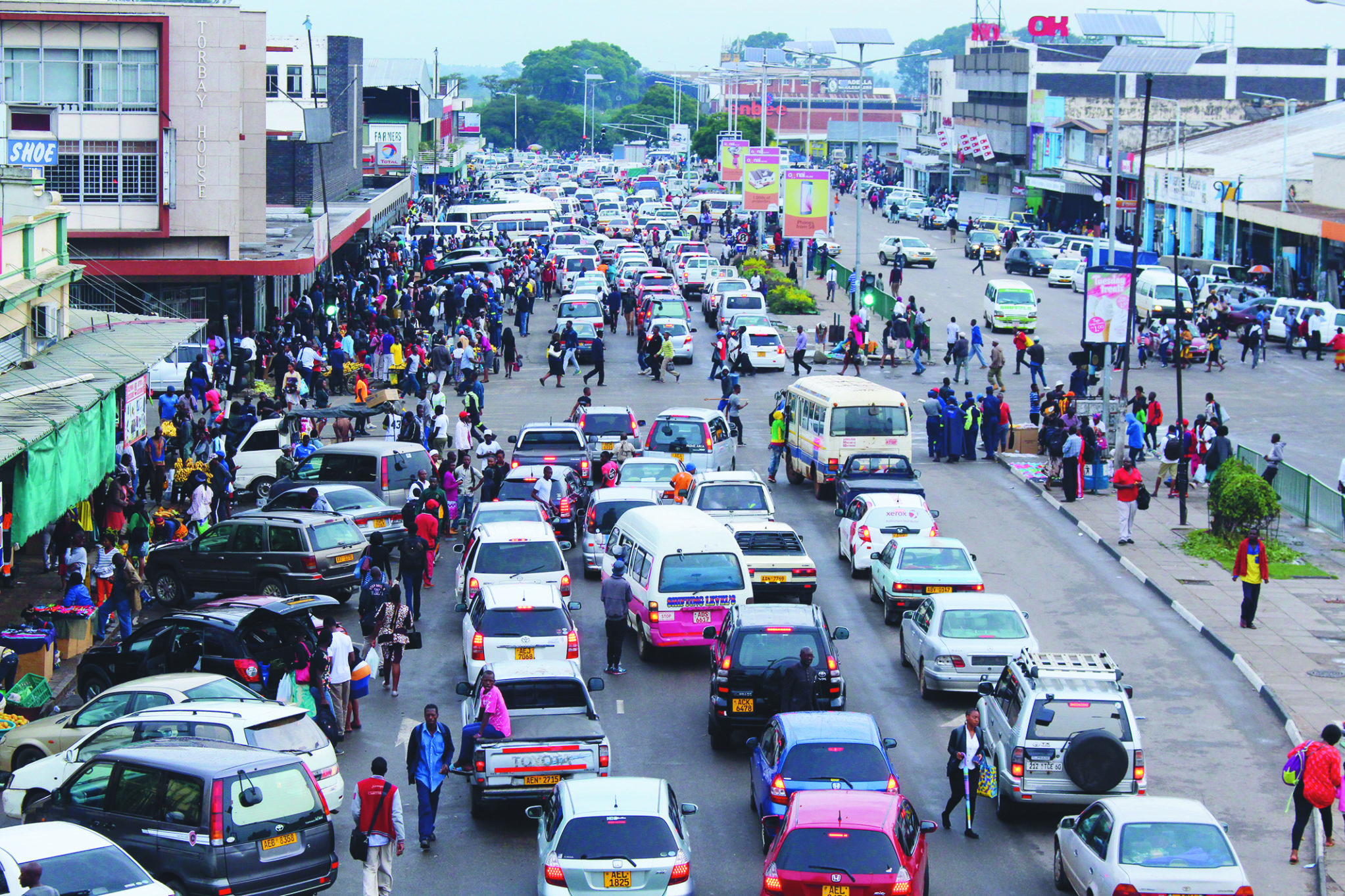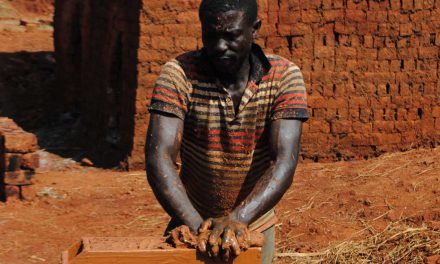
An aerial view of Johannesburg. Photo: iStock
Most of sub-Saharan Africa’s cities are ill prepared for the rapid and dramatic population increase that will occur by 2035
For decades to come, sub-Saharan Africa’s economic and social future will be shaped by one of the most important megatrends on the continent: urbanisation. Closely interlinked with demographic and economic trends, urbanisation is likely to shape politics in sub-Saharan Africa too.
The urban agenda has gained immense traction over the past years, both on the continent and globally. The notion that cities cannot make positive contributions to development is now largely outdated. Making cities inclusive, safe, resilient and sustainable, as stipulated by the UN’s Sustainable Development Goals, will be necessary if sub-Saharan Africa is to become more prosperous. However, this is also an extremely ambitious task.
Sub-Saharan Africa’s urban transition is in full swing; its urban population is the fastest growing globally. In less than 20 years, every second person in the region is likely to live in a town or a city, matching the current global situation. A third of sub-Saharan Africa’s countries – including South Africa, Nigeria and the Congo – have already crossed that threshold.
In the best case, urbanisation will help surmount some of the structural hurdles that continue to hold back sub-Saharan Africa’s prosperity. In the worst case, it will compound them. Most likely, the future will be a mixed picture, reflecting the diversity of sub-Saharan African countries, in particular their demographic and economic baselines as well as their quality of governance.
With 2035 as our time horizon, we can explore the following questions. What are the key characteristics of urbanisation in sub-Saharan Africa, and what does the future hold? Is the urban transition likely to translate into increased prosperity? And lastly, what should urban governance look like to capitalise on the opportunities that urbanisation brings about?
All the forecasts referred to in this article are based on the International Futures (IF) system (version 7.29). This is a large-scale, long-term, highly integrated modelling software programme housed at the Frederick S Pardee Center for International Futures at the Josef Korbel School of International Studies, at the University of Denver.
Sub-Saharan Africa is expected to account for close to a quarter of global urban population growth over the next 15 years. Its urban population is growing at an even faster annual rate than its population overall, at around 4% as compared to about 2.5%, respectively, in 2017. By 2035, more than 810 million Africans will live in cities and towns of different sizes. These include megacities with more than 10 million inhabitants, large cities with between five and 10 million inhabitants, medium-sized cities and smaller cities and towns. This is 348 million more urban citizens than today, or the equivalent of the combined current populations of Nigeria, Ethiopia, Angola and Mali.
By 2035, over 40% of sub-Saharan Africa’s urban population is expected to live in west Africa. With more than 60% of west Africans living in urban areas by then, west Africa will be Africa’s most urbanised region, surpassing north Africa. Central and southern Africa are forecast to cross the 50% urban population threshold before 2030, with central Africa leading the transition. East Africa/the Horn is the only region in sub-Saharan Africa that will remain predominantly rural in the longer term.
Natural urban population growth, or the predominance of births over deaths in urban areas, is the single most important driver of sub-Saharan Africa’s rapid urban population growth. The historical evidence shows that families living in urban areas have fewer children than families living in rural areas.
Yet, in sub-Saharan Africa, widespread poverty – as expressed in terms of income, as well as access to education and access to healthcare – means that fertility rates have remained high, including in cities and towns. Over time, fertility rates in urban areas will drop, but the fact that the number of extremely poor Africans is set to increase over the coming decades suggests that this might not happen quickly.
The second most important driver of urban population growth in sub-Saharan Africa is rural-urban migration, followed by cross-border inward migration. People tend to leave rural areas because of poor service provision, changing weather patterns, land pressures and natural disasters, as well as to escape violence and large-scale conflict. Between 2009 and 2016, the Boko Haram insurgency in north-eastern Nigeria, for example, has displaced an estimated 1.5 million people. The city population of Maiduguri, the capital of Borno State, may have more than doubled, to two million, due to the influx of internally displaced people.
With Lagos, Kinshasa, Johannesburg, Luanda and Dar es Salaam, sub-Saharan Africa will be home to five of the world’s expected 41 megacities by 2035. Next in line are Ouagadougou, Addis Ababa, Bamako, Dakar, Ibadan and Kano. Megacities in Africa – and in the developing world more generally – are growing at absolute rates unprecedented in history. Lagos, for example, is estimated to add an average of about 700,000 people every year. If the current trend holds, by 2035 close to 30 million people could live in Nigeria’s commercial capital, turning it into the largest megacity on the entire continent.
Kinshasa could have a population of close to 24 million, followed by Dar es Salaam with over 13 million. Megacities merit attention because they tend to absorb a significant share of national populations and are key drivers of their countries’ economic performance. They will therefore connect Africa to the global economy. However, the majority of Africa’s urban population lives in relatively smaller cities and towns, which are expanding incredibly fast as well.
Most of sub-Saharan Africa’s cities are ill-prepared for such rapid and dramatic population increases. The provision of land, finance, physical and social infrastructure, and other critical services, is bound to be a challenge, not least because of the massive backlogs that already exist.
Urbanisation in sub-Saharan Africa is not synonymous with economic development. In the Western context, urbanisation followed industrialisation and the ensuing economic diversification. However, sub-Saharan Africa is urbanising, but it is not industrialising. Urban population growth is outpacing economic development, precisely because of the lack of employment creation in higher productivity segments of the region’s economies. According to the World Bank, on average, up to 60% of the urban job market in sub-Saharan Africa is estimated to be informal.
Most sub-Saharan countries will see a tremendous increase in their share of the working-age population (aged 15 to 65 years) over the coming decades, particularly in urban areas. This is a potential economic booster. However, to translate this into economic development, any additional workers will need skills and productive jobs, and both are scarce. The prevalence of low-wage jobs in the informal sector is directly connected to the challenge of providing services for all from a small tax base, because most households are limited in their ability to pay for services.
Sharp income inequalities in many cities also mean that the contribution of economic growth to poverty reduction is limited. Africa has more urban poor than any other world region. New research from the World Bank indicates that poverty could be urbanising. And even though future improvements in urban poverty reduction are likely, the sheer number of urban poor in sub-Saharan Africa is expected to increase. This also implies that the number of people who will lack access to services such as clean water and improved sanitation is likely to increase dramatically. The 2016 African Economic Outlook report predicts that Africa could see its slum population triple by 2050.
Uncontrolled, rapid urbanisation in the context of pervasive poverty, inequality, large youthful populations and lack of economic opportunities does not bode well for the future sustainability of Africa’s towns and cities. Unplanned, overcrowded urban settlements populated by marginalised youth could become hotbeds for violence, particularly in lower-income informal areas. Indeed, urban areas are increasingly the locus for political violence in Africa. African urban areas have seen a considerable rise in the number of riots and protests occurring there.
With increasing levels of urbanisation, Africa’s urban constituencies are becoming increasingly important politically. In South Africa’s Gauteng province, for example, according to the Armed Conflict Location and Event Data Project at the University of Sussex, people took to the streets more than 1,900 times between January 1, 1997 and September 1, 2016 – more often than in any other current or emerging African megacity. On the other hand, terrorism in Africa to date is concentrated in rural rather than in urban areas.
It should be emphasised that the governance of African cities is incredibly complex. Local governments often have many responsibilities, while they lack the political power and resources to act on them. Across the continent, increasing levels of political conflict with higher levels of government is due to the fact that cities are typically the base of opposition political parties.
Generally, the nature of national and urban governance – understood as the ability of governments to effectively formulate and implement sound policies, as well as the quality of national and urban planning – will greatly influence whether urbanisation contributes to sub-Saharan Africa’s transformation.
Ad hoc urban governance, which serves the interests of the few who are wealthy at the expense of the many who are poor, is widespread across the continent. This approach will not lead to sustainable urban futures. Growth that does not benefit the poor is likely to exacerbate existing inequalities.
Countries and cities with healthy economic growth prospects, a reasonable regulatory environment, good planning and strategic investments in key sectors, such as physical and social infrastructure, are well placed to capitalise on the urban transition. Higher population density, combined with the economies of scale that are possible in urban areas, will mean that providing public services is more cost efficient than in rural areas. Investing in economic diversification, skills, and providing productive employment opportunities for a growing urban workforce, is key to promoting less unequal and therefore more sustainable urban futures.
Policymakers need to find approaches that combine interventions that improve peoples’ lives in the short-term with strategic investments that target longer-term returns and ensure sustainability. Propping up the informal sector with ad hoc measures, for example, might have short-term livelihood benefits, but it is unlikely to solve structural economic problems.
Effective urbanisation would drive broader industrialisation and economic structural transformation by providing a favourable business environment where companies can realise economies of scale and share knowledge easily. Similarly, services-led growth, by encouraging innovation and developing the skills of the urban labour force, would increase the supply of modern services to Africa’s growing urban middle class. This could also help attract more foreign direct investment to African cities by incentivising investment in well-connected urban corridors.
Urbanisation is not a silver bullet for sustainable economic development. However, the majority of respondents to an expert survey of country economists of the African Development Bank and the United Nations Development Programme, carried out by African Economic Outlook 2016, see urbanisation as an opportunity for their country and not as a risk.
Currently, we are seeing increasing momentum for countries to manage urbanisation in ways that support more inclusive and therefore more sustainable development outcomes. This momentum should also open channels for much-needed urban financing.
This article is based on African Futures Paper 20 African Urban Futures, Julia Bello-Schünemann and Ciara Aucoin, published by the Institute for Security Studies in November 2016.
Dr Julia Bello-Schünemann is a multilingual research consultant. She is versed in integrated forecasting across sectors (including demographics, infrastructure, economics, conflict and violence, etc.), trend and risk analysis, data analysis, policy advice for governments and international organisations. Her expertise straddles Africa, Latin America, the Caribbean, and the European Union. She possesses vast experience in project management, fundraising, strategic planning, multi-stakeholder consultations, training and facilitation. She is currently an Associate Senior Research Consultant with Good Governance Africa-Nigeria. She holds a PhD in International Relations from the Complutense University Madrid, Spain and an MA in Communication, Political Science and Economics from Ludwig-Maximilians-University, Munich in Germany.













